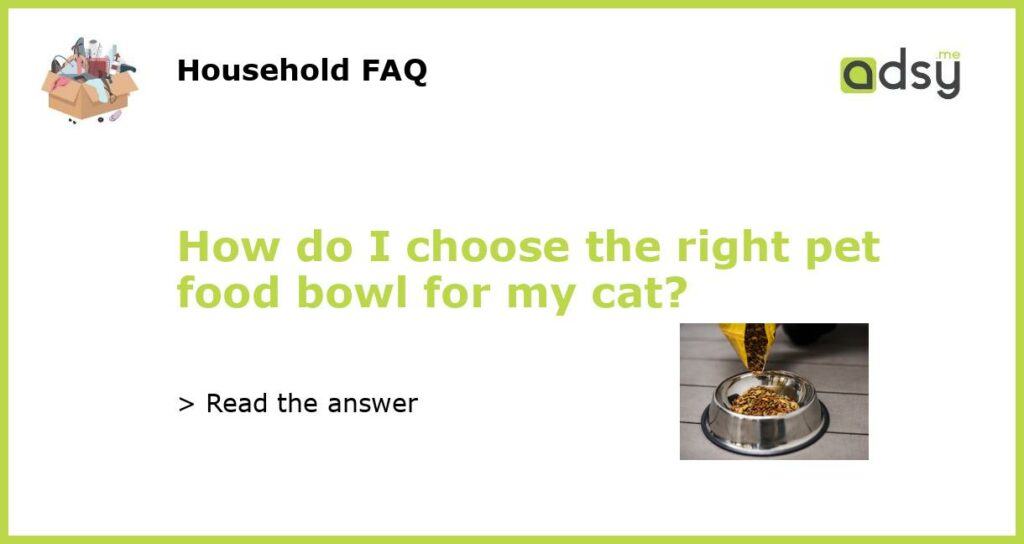Consider the Material
When choosing a pet food bowl for your cat, one of the first things to consider is the material. There are several options available, each with its own advantages and disadvantages. Some common materials used in pet food bowls include:
- Stainless steel: This material is durable, easy to clean, and resistant to bacteria. It is a popular choice for pet food bowls because it is less likely to cause allergies or skin irritations in cats.
- Ceramic: Ceramic bowls are heavy and less likely to tip over. They are also microwave and dishwasher safe. However, some ceramic bowls may have lead-based glazes, so make sure to choose one that is labeled as lead-free.
- Plastic: Plastic bowls are lightweight and inexpensive. However, they can harbor bacteria and may cause allergies or skin irritations in some cats. Look for BPA-free plastic bowls to ensure your cat’s safety.
- Glass: Glass bowls are another option, although they are less common. They are easy to clean and do not retain odors. However, they can break easily, so you need to handle them with care.
Consider your cat’s needs and your own preferences when choosing the material for their food bowl.
Decide on the Bowl Size
The size of the pet food bowl is another important factor to consider. It should be large enough to accommodate your cat’s food without causing any discomfort. Here are a few guidelines to help you determine the right bowl size:
- Small bowls: Suitable for kittens and smaller cat breeds. These bowls have a smaller capacity and are easier for kittens to access their food.
- Medium bowls: Suitable for adult cats of average size. These bowls have a moderate capacity and are suitable for most cats.
- Large bowls: Suitable for larger cat breeds. These bowls have a larger capacity and provide enough space for cats with bigger appetites.
Consider your cat’s eating habits and portion sizes when choosing the size of their food bowl.
Evaluate the Design and Functionality
The design and functionality of the pet food bowl can also affect your cat’s eating experience. Here are a few factors to consider:
- Bowl shape: Cats have sensitive whiskers, so choose a bowl with a wide and shallow shape. This will prevent their whiskers from touching the sides of the bowl and causing discomfort.
- Sloped or elevated bowls: Some cats prefer elevated or tilted bowls because it reduces strain on their neck and spine. These bowls can also help prevent digestive issues such as regurgitation.
- Non-slip base: Look for a bowl with a non-slip base to prevent it from sliding or tipping over while your cat is eating.
- Easy to clean: Consider how easy it is to clean the bowl. Look for bowls that are dishwasher safe or have a smooth surface that can be easily wiped clean.
Take into account your cat’s preferences and any specific needs they may have when evaluating the design and functionality of the food bowl.
Keep Your Cat’s Health in Mind
When choosing a pet food bowl, it’s important to keep your cat’s health in mind. Here are a few additional considerations:
- Allergies or sensitivities: If your cat has known allergies or sensitivities to certain materials, make sure to choose a bowl that is safe for them to use.
- Food intolerance: Some cats may have food intolerances and react negatively to certain materials. Pay attention to any abnormal behaviors or reactions your cat may have when using a specific bowl.
- Weight management: If your cat is overweight or prone to overeating, consider using a portion control bowl or puzzle feeder to slow down their eating pace.
Consult with your veterinarian if you have any concerns about your cat’s health or dietary needs when choosing a food bowl.
Budget and Longevity
Finally, consider your budget and the longevity of the pet food bowl. While it might be tempting to opt for the cheapest option available, remember that investing in a high-quality bowl can save you money in the long run. Cheap bowls may deteriorate quickly or may not be safe for your cat’s health.
Consider the durability and longevity of the bowl, as well as any warranties or guarantees offered by the manufacturer. Research customer reviews and ratings to get an idea of the bowl’s durability and overall quality.
Choosing the right pet food bowl for your cat is an important decision that can impact their eating habits and overall well-being. By considering the material, size, design and functionality, your cat’s health, and your budget, you can find the perfect bowl that suits both you and your feline companion.






